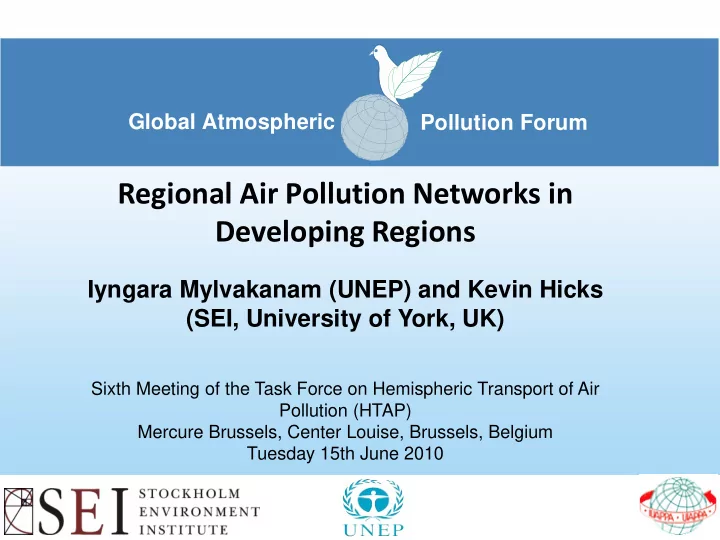

Global Atmospheric Pollution Forum Regional Air Pollution Networks in Developing Regions Iyngara Mylvakanam (UNEP) and Kevin Hicks (SEI, University of York, UK) Sixth Meeting of the Task Force on Hemispheric Transport of Air Pollution (HTAP) Mercure Brussels, Center Louise, Brussels, Belgium Tuesday 15th June 2010
Outline of Talk • Progress of existing intergovernmental networks in the developing regions: Africa, Asia – Pacific and Latin America and the Caribbean • Strengths and weaknesses of regional networks • Future prospects
International co-operation: progress so far Global: Montreal Protocol for Ozone Depleting Substances Stockholm Convention on POPs Intercontinental: UNECE CLRTAP Task Force on Hemispheric Transport of Air Pollutants Regional: Widespread emergence of regional co-operation, but variation in effectiveness and only limited co-operation between different regional initiatives
EANET Acid Deposition Monitoring Network in EAST ASIA (since 1998) EANET (13 countries) aims to: •Create common understanding about acid deposition in E Asia •Provide inputs to decision making in the region e.g. 2 nd RPM 2009 •Promote mutual cooperation on issues related to acid deposition •Monitoring, impacts and relevant policy framework are current focus
Association of South East Asian Nations (ASEAN) (since 1990) ASEAN (10 countries): Kuala Lumpur Accord in 1990. Regional legal agreement on haze entered into force in November 2003. Treaty on the control of haze pollution from forest clearance . Also, a sustainable cities initiative
Malé Declaration on the Control and Prevention of Air Pollution and its Likely Transboundary Effects in South Asia (since 1998) 8 SACEP countries have agreed to cooperate Network developed (annual meetings of FPs and NIAs) Scientific assessment has started (monitoring network set up in 2003/2004) Currently considering development of policy process
Central Asian Rebublics (Kazakhstan, Kyrgistan, Tajikistan, Turkemnistan, Uzebekistan) Convention on Environmental Protection for Sustainable Development of Central Asia – Article 8 on protection of the atmosphere Activities initiated at regional level by UNEP and UN/ECE UN/ECE CLRTAP assistance in developing national programmes and implementation plans
Clean Air Initiative – Asia (CAI-Asia) Promoting better air quality management in Asian cities through partnerships and sharing experience since 2001 28 cities, 19 government agencies, NGOs, academic institutions, development agencies and private sector Data portals on AQM and sustainable transport link to co- benefits (CitiesACT and Clean Air Portal) Better Air Quality in Asia conferences
Atmospheric Brown Cloud (ABC) Study to impact of ABC on monsoon change, water balance, agriculture and health Plan to set up ground based monitoring stations (some common with Malé Declaration) plus periodic aircraft monitoring concentrating on aerosols ABC plan to influence environmental policy and build capacity
Asia-Pacific Atmospheric Partnership (APAP) (Since 2009) Joint network of Asia networks and initiatives to promote closer co- operation The partnership has agreed in principle on cooperation and coordination Consultation ongoing with relevant inter-governmental meetings to develop implementation plan
APINA A ir P ollution I nformation N etwork for A frica (since 1997) Building partnerships across the continent with UNEP (PCFV), OSS, CAI-Africa, World Bank, USEPA Three subregional policy framework agreements at Ministerial level in Eastern, Southern and Western and Central Africa (North Africa in 2010) Action at national level on transport, urban planning and waste management
Latin America and the Caribbean (LAC) Intergovernmental network on air pollution (since 2008) Establishment of the network formerly agreed by Regional Forum of Environment Ministers in 2008 Network agreed policy framework and action plan recommendations for Ministers in 2009 In 2010 Ministers decided that Regional Action Plan should be prepared by 2012
Supporting Hemispheric and Global Cooperation Limitations of regional networks • Diversity in focus and institutional arrangements – but can also be a strength • Many poorly resourced with little contribution from member states • Individual countries at various stages of development and air pollution capability • Subject to regional political sensitivities • Instability from changing donor priorities, which do not always reflect regional concerns
Supporting Hemispheric and Global Cooperation Strengths of regional networks • Strong government ownership: all the networks are governed by the intergovernmental meetings • Many link with regional economic institutions and engagement of some global bodies e.g. UNEP • Stakeholders participation • Sustainability: The networks are not projects, which normally disappear after the project period. These networks are process integrated with the government system. • Regional scale and sub-regional appropriate for tackling many climate issues
Future Prospects Work of GAP Forum so far suggests strong potential for enhanced role of regional networks in tackling hemispheric and global pollution: • Institutional frameworks already in place • Provides interface with national and local concerns • Platform for harmonisation and skill transfer • Open to links with climate change and co-benefits • Building on commitment of member states, particularly smaller states • Support for transboundary programme strengthened by network’s parallel concern with national and local issues
Thank You
For More Information… Visit our website: www.gapforum.org
Recommend
More recommend